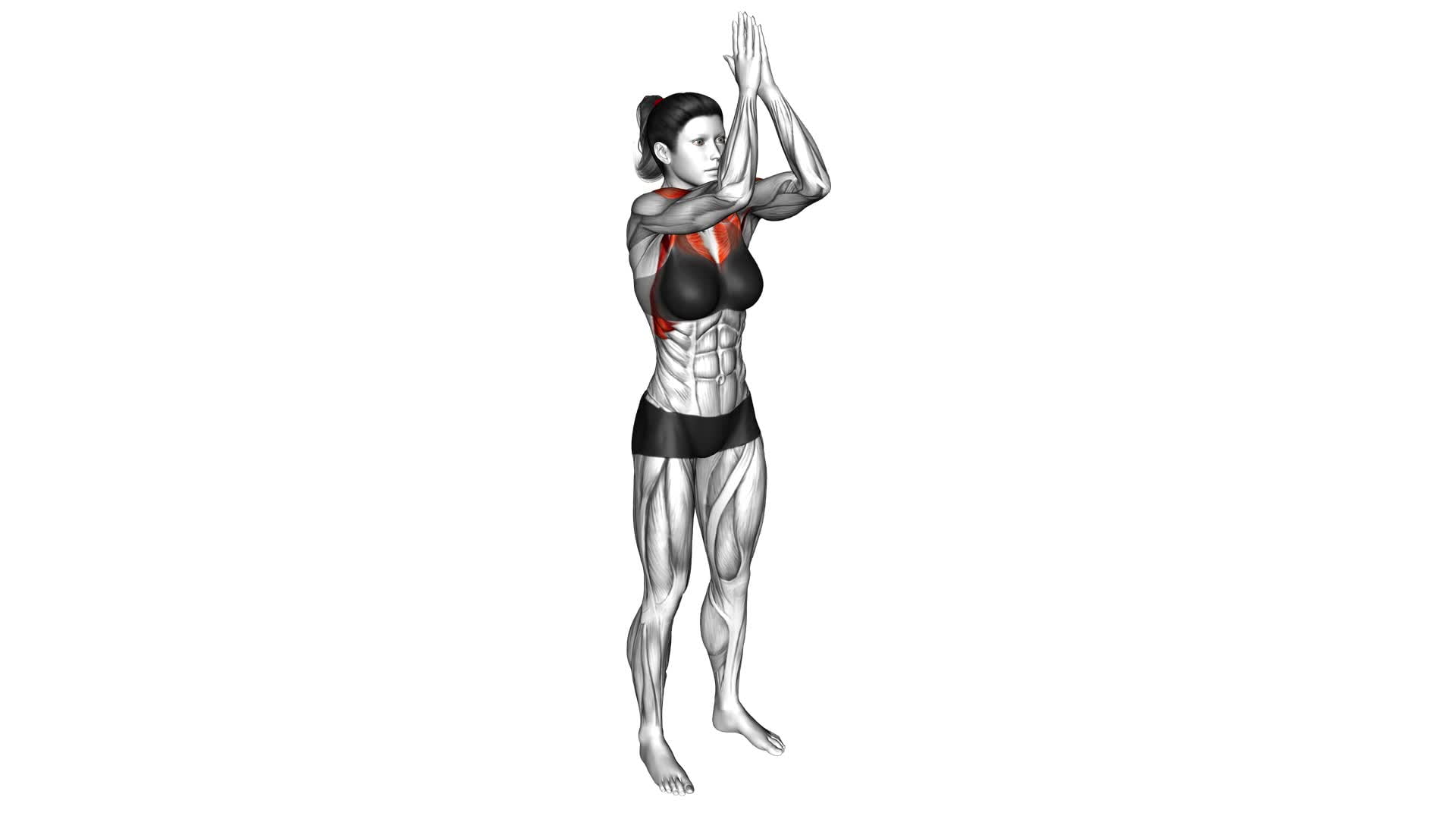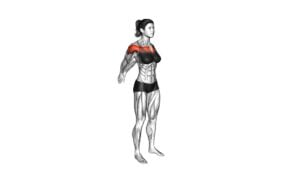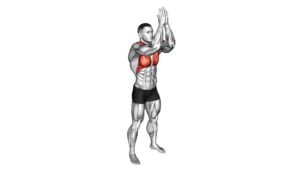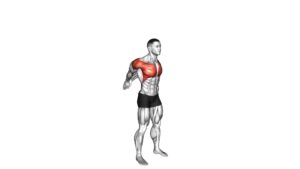Standing Elbow Clap (female) – Video Exercise Guide & Tips

Are you looking for a quick and effective exercise to strengthen your arms and improve upper body strength? Look no further than the standing elbow clap!
Watch This Exercise Video
In this video exercise guide, you'll learn the proper form and technique to perform this move correctly. We'll also cover common mistakes to avoid, modifications for different fitness levels, and tips to maximize your results.
Get ready to clap your way to stronger arms with this engaging workout!
Key Takeaways
- The Standing Elbow Clap is beneficial for increasing upper body strength and coordination.
- It improves muscular endurance and engages muscles in the shoulders, chest, and triceps.
- The exercise builds strength for tasks requiring prolonged upper body effort.
- Incorporating modifications and progressions can increase the intensity and challenge of the exercise.
Benefits of the Standing Elbow Clap
Increase your upper body strength and coordination with the Standing Elbow Clap exercise. This exercise is highly effective for improving muscular endurance and coordination.
Muscular endurance is the ability of your muscles to repeatedly exert force over an extended period of time. By performing the Standing Elbow Clap exercise, you engage the muscles in your upper body, including your shoulders, chest, and triceps. As you repeatedly clap your elbows together in a standing position, your muscles are working to generate and sustain the required force. This helps to build muscular endurance, allowing you to perform tasks that require prolonged upper body strength without fatigue.
In addition to muscular endurance, the Standing Elbow Clap exercise also improves coordination. Coordinating the movement of your arms and hands to clap your elbows together requires precise timing and control. By practicing this exercise regularly, you can enhance your coordination skills, which can have a positive impact on your overall physical performance and daily activities.
Proper Form and Technique
To perform the Standing Elbow Clap exercise correctly, focus on maintaining proper form and technique throughout the movement. Begin by standing with your feet shoulder-width apart and your arms extended out in front of you. Keep your core engaged and your back straight. As you bring your arms out to the sides, make sure to keep them at shoulder height, forming a 90-degree angle with your elbows. This is the starting position.
To execute the exercise, simultaneously bring your elbows together in front of your chest, clapping them together. Then, return to the starting position by extending your arms out to the sides. Throughout the movement, it's important to keep your upper body stable and avoid any excessive swinging or twisting.
Proper alignment is crucial to maximize the effectiveness of the Standing Elbow Clap exercise. Make sure to keep your shoulders down and relaxed, and avoid shrugging or tensing them up. Additionally, maintain a neutral neck position by looking straight ahead, rather than tilting your head up or down.
Common Mistakes to Avoid
To perform the Standing Elbow Clap exercise correctly, avoid the common mistake of hunching your shoulders during the movement. Hunching your shoulders can lead to poor form and improper technique, which can diminish the effectiveness of the exercise and increase the risk of injury.
Another common mistake to avoid is using excessive force or momentum to complete the movement. The Standing Elbow Clap exercise is meant to be a controlled and deliberate movement, focusing on engaging the muscles in your arms and shoulders. Using too much force or momentum can take away from the targeted muscle engagement and compromise the effectiveness of the exercise.
Additionally, it's important to maintain proper posture throughout the exercise. Avoid arching your back or leaning forward, as this can put strain on your lower back and compromise your form. Instead, keep your back straight and engage your core muscles to support your spine.
Lastly, make sure to use the appropriate weight or resistance level for your fitness level. Using weights that are too heavy can lead to improper form and increase the risk of injury. Start with lighter weights and gradually increase the resistance as you build strength and confidence in your ability to perform the exercise with proper technique.
Modifications and Progressions
Try incorporating variations of the Standing Elbow Clap exercise to challenge your muscles and progress your fitness routine. If you're looking for alternative exercises that target the same muscle groups, you can try the Standing Chest Press or the Push-Up with Rotation.
The Standing Chest Press is a great option that mimics the motion of the Standing Elbow Clap but focuses more on the chest muscles. To perform this exercise, stand with your feet shoulder-width apart and hold a dumbbell in each hand at shoulder height. Press the dumbbells forward, extending your arms in front of you, and then return to the starting position.
The Push-Up with Rotation is another alternative exercise that adds an extra challenge to your upper body. Start in a push-up position, perform a push-up, and then rotate your body to one side, extending one arm towards the ceiling. Return to the starting position and repeat on the other side.
These alternative exercises will help you continue to strengthen your upper body while adding variety to your routine.
If you're looking for advanced variations of the Standing Elbow Clap, you can try the Plyometric Push-Up or the Clapping Push-Up. The Plyometric Push-Up involves explosively pushing yourself off the ground during the upward phase of the push-up, allowing your hands to briefly leave the ground. This variation increases the intensity and power required for the exercise.
The Clapping Push-Up takes the Plyometric Push-Up one step further by adding a clap in mid-air before landing back in the starting position. These advanced variations require greater upper body strength and explosiveness, so make sure you have a solid foundation and proper form before attempting them.
Remember to always listen to your body and progress at a pace that's comfortable for you.
Tips for Maximizing Results
To maximize your results with the Standing Elbow Clap exercise, focus on maintaining proper form and gradually increasing the intensity of your workouts. Proper form is essential to target the muscles effectively and prevent injury. Start by standing with your feet shoulder-width apart and your knees slightly bent. Keep your core engaged and your back straight throughout the exercise. As you perform the elbow clap, make sure to fully extend your arms and bring your elbows together at chest height.
To maximize intensity, consider incorporating weights into your workouts. You can hold dumbbells or kettlebells in your hands while performing the exercise. This will add resistance and challenge your muscles even more. Start with lighter weights and gradually increase the load as you become stronger and more comfortable with the exercise.
Another way to maximize results is to increase the number of sets and repetitions over time. Begin with 2-3 sets of 10-12 repetitions and gradually work your way up to 3-4 sets of 15-20 repetitions. This will help improve muscular endurance and promote muscle growth.
Remember to listen to your body and give yourself enough rest between workouts. Aim for at least one day of rest between each session to allow your muscles to recover and grow stronger.
Frequently Asked Questions
What Are Some Alternative Exercises That Target the Same Muscle Groups as the Standing Elbow Clap?
Looking for alternative exercises that target the same muscle groups as the standing elbow clap? Here are a few options to consider.
Try push-ups, tricep dips, or bench presses to work your chest, shoulders, and triceps. For beginners, modified push-ups on your knees or against a wall are great modifications.
Incorporating these exercises into your routine can help you achieve strong and toned upper body muscles.
Can the Standing Elbow Clap Be Done by Individuals With Shoulder or Elbow Injuries?
If you have shoulder or elbow injuries, it's important to consider modifications for the standing elbow clap exercise.
While the standing elbow clap may not be suitable for individuals with these injuries, there are alternative rehabilitation exercises that can target the same muscle groups.
It's crucial to consult with a healthcare professional or physical therapist who can provide guidance on specific exercises that are safe and appropriate for your condition.
How Many Sets and Reps Should Be Performed When Incorporating the Standing Elbow Clap Into a Workout Routine?
When incorporating the standing elbow clap into your workout routine, it's important to consider the optimal sets and reps. Start with 3 sets of 10 reps and gradually increase as you build strength and endurance. Remember to listen to your body and adjust as needed.
Additionally, there are variations of this exercise that target the same muscle groups, such as the seated elbow clap or the kneeling elbow clap. Experiment with these variations to keep your workouts challenging and effective.
Is It Necessary to Warm up Before Performing the Standing Elbow Clap Exercise?
Before performing the standing elbow clap exercise, it's important to warm up. Warming up helps increase blood flow to your muscles and prepares them for the workout. It also reduces the risk of injury.
Additionally, proper form is crucial in performing the standing elbow clap. Maintaining correct alignment and engaging the core will help you get the most out of the exercise and prevent strain on your joints.
Are There Any Specific Breathing Techniques That Should Be Followed While Performing the Standing Elbow Clap?
When performing the standing elbow clap exercise, it's important to follow specific breathing techniques. Proper breathing can greatly enhance the benefits of this exercise.
By inhaling deeply through your nose and exhaling forcefully through your mouth, you can engage your core muscles and increase your overall stability. This controlled breathing also helps to oxygenate your muscles and improve your focus during the exercise.
Conclusion
In conclusion, the standing elbow clap is a beneficial exercise that can help improve upper body strength and coordination.
By following proper form and technique, avoiding common mistakes, and making necessary modifications or progressions, you can maximize the results of this exercise.
Remember to focus on your goals and listen to your body to ensure a safe and effective workout.
Keep up the good work and enjoy the benefits of the standing elbow clap!

Author
Years ago, the spark of my life’s passion ignited in my mind the moment I stepped into the local gym for the first time. The inaugural bead of perspiration, the initial endeavor, the very first surge of endorphins, and a sense of pride that washed over me post-workout marked the beginning of my deep-seated interest in strength sports, fitness, and sports nutrition. This very curiosity blossomed rapidly into a profound fascination, propelling me to earn a Master’s degree in Physical Education from the Academy of Physical Education in Krakow, followed by a Sports Manager diploma from the Jagiellonian University. My journey of growth led me to gain more specialized qualifications, such as being a certified personal trainer with a focus on sports dietetics, a lifeguard, and an instructor for wellness and corrective gymnastics. Theoretical knowledge paired seamlessly with practical experience, reinforcing my belief that the transformation of individuals under my guidance was also a reflection of my personal growth. This belief holds true even today. Each day, I strive to push the boundaries and explore new realms. These realms gently elevate me to greater heights. The unique combination of passion for my field and the continuous quest for growth fuels my drive to break new ground.







